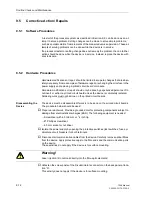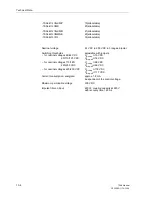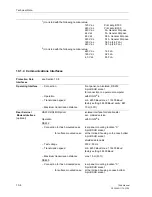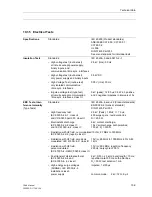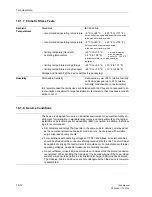
Routine Checks and Maintenance
9-13
7SA6 Manual
C53000-G1176-C156-2
o
If the device has more communication interfaces at locations “B” and/or “C” on the
rear, the screws located diagonally to the interfaces must be removed.
These activities are not necessary if the device is for surface mounting.
o
Remove the corner covers on the front panel and loosen the screws that are holding
the front panel to the device case.
o
Carefully pull off the front panel. The front panel is connected to the CPU board with
a short ribbon-cable.
On devices with detached operator panel, the front panel can be pulled off directly
(without a ribbon cable).
o
At one end, disconnect the ribbon-cable that links the front panel and the CPU board
(
), at the side of the front panel. To disconnect the cable, push up on the top latch of
the plug connector and push down on the bottom latch of the plug connector. Carefully
set aside the front panel.
For the surface mounted device, the 7-pin connector X16 must be disconnected from
the CPU board behind the D-subminiature port, and the ribbon-cable that runs to the
68-pin connector on the back must be detached.
o
Disconnect the ribbon-cable between the CPU board and the I/O board.
o
The boards can be removed and laid on the grounded mat to protect them from ESD
damage.
A greater effort is required to remove the CPU board from the device designed for sur-
face mounting, because of the type of connectors.
Replacing the
Power Supply Fuse
The power supply fuse is located on the CPU board.
o
Keep ready replacement fuse 5 x 20 mm. Verify the correct rating, correct character-
istic (T) as well as the correct coding.
This data is printed on the module (see Figure 9-7). The type of fuse depends on the
auxiliary supply voltage, e.g. for 24 to 48 VDC the fuse type “T4H250V” according to
IEC 60127–2 is required (refer to Table 9-1). To maintain the UL–approval, only UL
approved fuses may be used (e.g. Messrs. Wickmann. type 181).
o
Remove the defective fuse. Figure 9-7 illustrates the fuse.
Caution!
Electrostatic discharges through the connections of the components, wiring, and con-
nectors must be avoided! Wearing a grounded wrist strap is preferred; otherwise, first
touch a grounded metal part. Do not insert or remove interface connectors under live
conditions!
Warning!
Hazardous voltages may exist in the device, even after the power supply is discon-
nected and the boards are withdrawn from the case! Capacitors can still be charged!
Summary of Contents for siprotec 7SA6
Page 2: ...Siemens Aktiengesellschaft Book No C53000 G1176 C156 2 ...
Page 18: ...xviii 7SA6 Manual C53000 G1176 C156 2 ...
Page 32: ...Introduction 1 14 7SA6 Manual C53000 G1176 C156 2 ...
Page 82: ...Hardware and Connections 2 50 7SA6 Manual C53000 G1176 C156 2 ...
Page 119: ...SIPROTEC 4 Devices 4 25 7SA6 Manual C53000 G1176 C156 2 Figure 4 20 CFC Logic example ...
Page 190: ...Configuration 5 62 7SA6 Manual C53000 G1176 C156 2 ...
Page 652: ...Installation and Commissioning 8 78 7SA6 Manual C53000 G1176 C156 2 ...
Page 724: ...Technical Data 10 56 7SA6 Manual C53000 G1176 C156 ...
Page 800: ...Appendix A 76 7SA6 Manual C53000 G1176 C156 2 ...
Page 866: ...Appendix B 66 7SA6 Manual C53000 G1176 C156 2 ...














